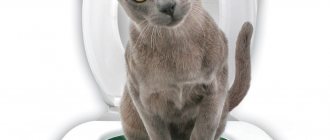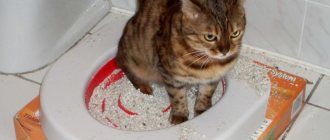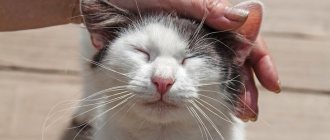How to train a cat to use the toilet after using the litter box?
If the owner wants his cat to go not to the tray, but to the toilet, this is not a whim at all. This method of providing animals with their natural needs has a number of advantages:
- There will be no cat litter box in the house. For many, placing this element of a pet dowry is difficult, especially if the home is small. Firstly, cats like to go to the toilet in a secluded place; a corner is needed for the litter box. Secondly, cats do not go to the toilet where they eat. Thirdly, sometimes a cat potty spoils the aesthetics of the room. One cannot but agree that it is much more convenient if the animal goes to the toilet.
- There will be no need to waste time and money on buying litter for the tray. Despite the fact that the filler is relatively inexpensive (depending on the type, of course), you usually need a lot of it, and a lot of money goes out of the family budget. Cat on the toilet - savings for the family.
- If a cat relieves itself on the toilet, the house will not smell of its discharge, and there will be no traces of wet paws on the floor. Of course, provided that they immediately clean up after the fluffy one. But even if the cat’s “business” goes unnoticed for some time, the toilet is an isolated room with good ventilation.
If a cat goes to the toilet, it is convenient, economical and hygienic.
IMPORTANT: Only an adult healthy cat who uses a litter tray can be toilet trained. A small kitten may fall into the bowl of a plumbing fixture, choke or get injured. You need to wait until he grows up. An old cat with sore joints or an overweight animal is unlikely to jump on the toilet and, most likely, will make puddles and piles on the rug next to it. These nuances must be taken into account.
How to train a cat to use the litter box so that later it can go to the toilet is written in this article: link
They say that animals, like people, develop a habit within three weeks. Of course, all cats are individual, and some especially lazy ones need much more time to toilet train, up to 2 months. But experienced cat owners say that absolutely everyone can be taught to go to the toilet.
Preparing to teach an animal to relieve itself in the toilet consists of three stages and requires certain preparation from the owners:
- It is necessary to prepare the bathroom, remove everything unnecessary from there, and free up space near the toilet where the cat's potty will be temporarily located. If we are talking about a private house or a large apartment with several bathrooms, choose the one that is more accessible for the cat, for example, on the ground floor.
- You will also need some equipment: a potty that the cat usually goes into, a training tray (discussed below), litter that can be flushed down the drain, cardboard boxes or old newspapers that will lift the tray.
- Learn to keep the bathroom door open so that the cat can come in at any time.
- Learn to keep the toilet lid open. Guests at home will always have to be warned about this. If the owners have the habit of lowering the lid, they themselves will have to relearn. You need to remember: if the cat is accustomed to the toilet, its closed lid equals a puddle or pile in the corner.
- Stock up on detergents, because now you will have to wash and clean the toilet more often.
IMPORTANT: If you can’t buy a convenient training kit for training your pet to go on the toilet, you can make it yourself, or even do without it.
Only adult healthy cats who regularly use the litter box are trained to use the toilet.
When the bathroom is ready, the cat's litter box is moved into it. It is better to do this gradually, moving the tray closer and closer to the toilet so that the cat does not get confused and start “walking” anywhere. Afterwards the actual training begins:
- The first stage takes approximately two weeks. The tray is placed near the toilet. Cardboard or newspapers are placed under it. Every day they raise the tray higher and higher, so that eventually it is level with the toilet. The cat will get used to the fact that he will need to jump onto the tray, and then he will easily climb onto the toilet.
- If there is no special tray, a regular one with low sides is placed on the toilet lid. Leave it in this position for two days so that the cat gets used to jumping on the toilet every time he wants to go to the toilet.
- Remove the potty from the toilet. They monitor the animal’s behavior for several days, identifying whether it has developed the habit the owners need.
Stages of toilet training a cat.
IMPORTANT: If, when training a cat to go to the toilet on the toilet, he commits sins a couple of times, under no circumstances should you scold him for this. Such a way of relieving himself is unnatural for him, contrary to his instincts. The animal is under stress, you need to be patient and consistent.
Toilet training a cat: stage 1.
Toilet training a cat: stage 2.
If toilet training ends in failure, do not despair. Each cat has its own individual characteristics. They don't like confined spaces.
Others are shy, they instinctively bury their feces, and the option without litter is not for them. Still others find it uncomfortable to sit on the toilet lid because of their size, etc. When you get a pet, you need to think not only about your desires, but also about its comfort.
Moreover, now you can choose the trays for cats that you want, this article will help you choose the most convenient one: link
Overlay systems
Veterinary stores sell designs that help you easily accustom a cat to the toilet in an apartment. They are produced for animals of all ages - for young kittens and adult cats:
- letter-quitter - a cover made by Chinese manufacturers, made of plastic; following the instructions, you can accustom a cat to the toilet in an apartment in 2 months;
- cat houses - the design is intended for adult animals that are 3-4 months old;
- anti-scratch – Russian-made pad, holes are made by hand.
Purchased pads will allow you to accustom your cat to using the toilet in an apartment in a short time, but after each cat litter you need to wipe them with delicate hygiene products to remove the smell of urine.
The younger the kitten, the better it can be trained.
Toilet training system for cats. Set, simulator for accustoming a cat to the toilet
For the convenience of owners and animals, manufacturers of products for cats produce special systems for training cats to use the toilet on the toilet.
Their configurations may vary, but the principle remains the same: a device similar to an ordinary cat potty is gradually modified, turning into something similar to a toilet seat.
The most popular training systems due to their convenience are:
- Domakot
- Unicott
- Litter Kwitter
- CitiKitty Cat Toilet Training Kit
- VACA
Systems for toilet training a cat.
IMPORTANT: Such simulators cost a decent amount, 600 to 4000 rubles depending on the manufacturer.
Toilet training with the Litter Kwitter system.
Toilet training using this system in the early stages differs little from the one described above.
- A training tray with a solid bottom is filled with litter that the cat usually uses. The tray is placed near the toilet.
- Gradually raise the tray, leveling it in height with the toilet lid over the course of two weeks. At the same time, the filler is gradually changed to one that can be flushed down the toilet.
- Install the training system directly on the toilet. It still looks like a regular tray. When the cat confidently jumps on the toilet and goes to the potty, you need to replace the solid tray with a tray with a hole, if it is a Litter Kwitter system, go cut off the smallest ring in the center of the tray, if it is Domakot.
- After a couple of days, enlarge the hole in the center of the pan or replace the pan. Accordingly, pour less filler into the tray.
- Gradually increase the diameter of the hole in the tray to the diameter of the toilet bowl. Then you can remove the training tray completely. As a rule, training on the system after installing it on the toilet takes 10-14 days.
Toilet training with the DOMAKOT system.
The simplest simulator for training a cat to use the toilet is a plastic attachment with a small hole. It is installed on top of the bowl of the sanitary ware.
A simple simulator for training a cat to use the toilet.
The advantage of this type of design is that it is very ergonomic, so a small cat can use the toilet.
General rules
To prevent a cat's use of the toilet from turning into torture, one should understand that a cat is a rational creature and it is necessary to approach the process of education with this axiom. There are no stupid cats, only impatient owners.
Take the cat to the toilet in advance, pick it up, caress it and flush it. Talk to the animal and press the drain from time to time so that the scary sounds are associated with something pleasant.
Toilet training should not be forced. Affection, persuasion and even cunning are the main means in this process.
It should be noted that toilet training a small kitten works one hundred percent, but attempts to sit an adult cat on it may be unsuccessful. After all, a cat is an animal that does not like to change its habits.
DIY toilet seat for cats
In the absence of funds for a training tray, you can make a similar design from:
- aluminum pallet
- plastic plate
- cat potty mesh
Homemade toilet seat for a cat from a mesh tray.
- At the third stage of training, when the cat jumps to the height of the toilet, the specified device is attached to the toilet bowl or under its seat. Typically, strong masking tape is used for this.
- Just as when training using the system, first use the structure as a regular tray, pouring filler into it.
- They cut a hole in the center of the structure and gradually increase its diameter, bringing it to the diameter of the toilet bowl. Pour a smaller amount of filler into a tray with a hole.
- The structure is removed when the cat learns to walk into the hole without filler, holding onto the toilet seat with all its paws.
Who can be trained and who shouldn't
Almost any cat can be trained to use the toilet. However, there are certain restrictions. Who should not be toilet trained:
- cats leading a sedentary lifestyle and pregnant cats - because of their awkwardness;
- It is also better to leave nursing cats alone;
- older, sick or weakened cats should not be tormented by attempts to give up the tray;
- Kittens that are too small are not yet ready to go to the toilet; they are at risk of falling.
The optimal age for training a cat is 5-6 months. At this age, their psyche is still flexible enough to learn a new skill, and they are not too young to fall awkwardly.
Choosing toiletries for your furry pet
If the decision to get a kitten or an adult cat was not made spontaneously, then you need to stock up in advance on the necessary things required for the normal maintenance of the animal.
Need to purchase:
- tray;
- filler.
You must purchase the tray and filler in advance
In addition, you will need to decide on the location of the pet’s toilet.
Selecting a tray
In pet stores you can see a very large number of trays, differing in design, size and construction. The most common and popular are plastic products. They are inexpensive, easy to clean, and come in a variety of sizes and colors. Plastic modifications of pots with mesh are offered, which do not require filling. There are closed-type options, which are kind of small houses. But caring for such pots is much more difficult.
Trays vary in size and height
Automatic cat litter box requires virtually no maintenance
For a small kitten, a not very large tray with low sides (5–7 cm) is suitable, otherwise the baby simply will not be able to climb into it. But if the sides are too low, then when the pet begins to diligently bury its feces, some of the filler will always fall out onto the floor. When the kitten gets a little older, you can offer him a tray with a more spacious design.
A toiletry product for an adult animal is chosen based on the size of its body. A large individual will need a large and deep tray. A smaller cat may need a smaller pot.
If the space allows, you can purchase a closed tray for your pet.
It is important that the entire structure is stable. A cat may accidentally knock over a tray that is too light when it steps on its edge.
Subsequently, the pet will be afraid to go there.
From personal experience. We adopted an adult cat for foster care. The owners brought it along with their own toilet, litter, bowl and other household items. The tray was placed next to the existing one. Coincidentally, the filler turned out to be the same, and the nosy cat immediately climbed into our cat’s potty. But she is very tiny, and her tray is also very small. The guest in it was barely able to turn around, almost knocked him over and didn’t go there again.
Selecting filler
Cats are picky eaters and they all like different types of litter. When choosing a composition for a kitten, you need to focus on the type that was used in the pot of its parent. The familiar smell will attract the baby there. If he was picked up on the street or is not yet toilet trained at all, then you should opt for safe wood pellets.
For small kittens, it is recommended to fill the pot with safe wood filler.
For adults, a gel or silicone filler is suitable. But not all cats like the crunch that occurs when walking on such granules. It is not recommended to use these varieties for kittens, as babies may accidentally swallow the gel balls. When they enter the gastrointestinal tract, they increase in volume many times over, which can lead to intestinal obstruction.
For adult cats, silica gel litter is recommended.
Clumping material is very convenient because it does not require frequent replacement. It is enough just to periodically remove the formed lumps. Clay mineral compositions are highly absorbent, so they are chosen for very large cats or if there are several mustachioed pets living in the house.
There is no need to frequently change the entire filler; it is enough to remove the formed lumps
Choosing a place for the toilet
It is extremely important to choose a calm, quiet and non-traffic area for the cat's litter box. The animal needs peace and solitude while performing its natural needs.
He should not be disturbed by his owners or other animals. Your pet will also feel uncomfortable near noisy household appliances.
The place for the tray should be quiet and secluded
You should not place a potty next to food and water bowls, as cats do not like to defecate where their food is. The ideal place is a bathroom, toilet room or closet. The door must be open at all times so that the animal has easy access to its toilet.
Training a one-month-old kitten
A one-month-old baby should be with its mother. During this period, he strengthens his immunity with the help of milk, and also receives social skills from an adult cat and brothers and sisters. It is the mother cat who usually shows her children how to go to the toilet correctly. But sometimes such babies are left alone, and a person has to partially take on the role of mother.
The baby is still very poorly oriented in space and does not always walk confidently, so his place of residence should be limited. In a small space you should place the necessary items:
- Bed;
- Bowls for food and water;
- Tray.
A one-month-old baby is practically a baby: he is scared without his mother, it’s cold, and he doesn’t understand why he ended up in this place. At this age, you should accustom your baby to a long process.
Key principles:
- The tray is in sight;
- The filler is clean and fresh;
- After eating, the tummy should be massaged with cotton wool or a soft cloth;
- Monitor your baby closely;
- As soon as he starts to worry, he puts him in the toilet container and waits;
- If the kitten ran away and made a puddle in another place, then transfer the moisture on a napkin to the tray to fix the smell.
Calmness, goodwill and affection will significantly speed up the process, because the baby will begin to feel safe.
What to do if you have difficulty teaching your cat to go to the toilet?
1. It happens that a kitten often makes mistakes - it shits in the corners, and you are desperately looking for advice on how to train a cat to go to the litter box. In such a situation, control over the animal and patience are necessary. Try to analyze whether you have caused a negative association in the furry one. Maybe he relieved himself in the potty, wet his paws, and you immediately took him to wash him. Or the noise of water near the tray is scary for the kitten - this causes discomfort in the animal. Try to develop a good association. Buy kitten treats, such as vitamins. It is advisable to break each tablet into 2 parts - because The kitten goes to the toilet often. As soon as your pet goes to the litter box, reward him with a vitamin.
2. It happens that Murka doesn’t like the filler. There are many of them with different flavors. Fillers are divided into 2 categories:
- clumping: when moisture is absorbed, they form lumps that are easy to remove.
- absorbent: absorb moisture, neutralize odor.
Try changing the filler. According to reviews from cat owners, the reason lies precisely in this.3. Do not poke your animal's nose into the feces. Bring it to the puddle, let it sniff - so that the cat understands that this is his “job”. After this, scold in a strict intonation. Cats are very sensitive to human voices. It will work.
4. Do not punish an animal if you did not catch it at the moment of the “crime”. Fluffy will not understand why he is being scolded.5. If the cat gets into the habit of going to one or two favorite places, scare it away with the scent of menthol (lubricate the corner with menovazine) or cologne.
6. Buy the “Sharp Cat” product. A few drops of a special substance in the pot will attract the animal, and the cat will regularly go to the toilet.
7. If your pet’s potty training takes a long time, you need to develop a chain in cat psychology: if you shit, you get discomfort. This could be splashes of water on the cat at the moment of a misfire.
8. Clean the tray in a timely manner. Cats are very sensitive to odors. When the litter box smells bad, the cat will make a toilet in another place.
9. If the cat refuses to go into the litter box after doing a wet job there, only one method helps: buy him a second potty. The problem ends there.
We are often asked questions about how to train a Scottish kitten to go to the toilet and how to train an adult cat to use the litter box.
In fact, it doesn’t matter what breed your cat is or how many months/years he is. Only the duration of training depends on age
Cats are affected by the same principles
Try to give them due attention so that puddles in the corners are not a way of revenge or attracting attention
Now you know how to potty train a cat. Put these steps into practice. The main condition is patience. Cats are very sensitive to humans. Therefore, influence them with love. This way your authority will quickly be established, and the cat will unquestioningly comply with your demands. You should not use force, because... the cat will take revenge.
If you dream of teaching a cat to go to the human toilet, i.e. on the toilet, watch a funny training video: How to train a cat to use the toilet in the toilet.
What you need to know about trays
Before you train your kittens to a specific place for their needs, you need to purchase a suitable litter box. The design should be comfortable for both the kitten and you. Otherwise, the four-legged one will ignore the place allocated for the toilet and choose its own, suitable for it in all respects.
Almost all trays are made of plastic, but it varies. A chemical smell and a flimsy design that bends under the weight of even a small kitten will be your failure in the training process. Remember that cats have a very sensitive sense of smell and the slightest chemical smell from the litter box will scare them away forever.
Before you train an outdoor kitten or a purebred cat, take a closer look at the animal’s temperament and character
If you have a shy cat or an active kitten who digs into the litter with adoration, pay attention to a closed toilet. Open designs are relevant for owners of several cats
The dimensions of the tray depend on the breed and size of the animal. Of course, a compact “potty” looks neater, but it is hardly suitable for a small breed kitten. But a purebred Maine Coon or an adult British Fold cat is unlikely to appreciate such an infringement of their feline rights. For closed trays, not only the size of the base is important, but also the height. The pet should be able to fully stand on its paws without resting on the “roof”.
Another important parameter is the need to use filler. The design with a grid-limiter is undoubtedly convenient, but not all adult cats will agree to such a tray. It is necessary to teach it from a very young age.
Note! On websites you can often find private advertisements for the sale of used trays; often they are even offered to be given as free gifts. Your cat won’t appreciate such savings; the whole point is that the smell of someone else’s pet will forever remain on the plastic tray, even if you don’t feel it
7 rules of the cat litter box:
Each cat in the house should have its own personal litter box. Yes, one tray for everyone is convenient, but not comfortable for pets. Each time they will try to re-mark a strategic territorial resource in the house
This way you will get endless gang wars between the tailed ones. The location of the toilet should be convenient for the cat, not you, and there will be no compromises on this issue. If you purchased a litter tray, pay attention to how the cat treats it. Sometimes changing the filler to a perfumed one with fragrances can permanently discourage you from using the toilet
It may seem to you that the aroma is pleasant and you are doing everything for the benefit of your pet, but the cat will not think so. After all, he has 200 million receptors, and we have only 5 million. In a filler, not only the aroma or lack thereof is important, but also the consistency. Cats with declaws removed will not be comfortable on litter with sharp-angled particles. Pay attention to your pet's health. The older the cat, the easier and easier it should be to climb into the tray; no high sides, additional doors or intricate details. Often human behavior is projected onto the animal. We are accustomed to the fact that the toilet should be a secluded place, hidden from prying eyes. But cats don’t need this, so not all pets like closed toilets. In addition, the lid on top blocks the view and the cat is not comfortable, because he does not see the likely impending threat. A closed tray with a transparent roof would be a good alternative. The contents of the tray should be removed systematically and, if possible, immediately. Believe me, your pet does not experience any pleasure from moving through a “mined field.”











